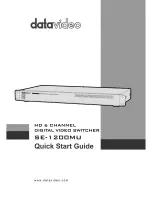
SICOM Series CLI Command Manual
36
Chapter
9
DT-VLAN
protocol
configuration
9.1 Introduction of DT-VLAN protocol
DT-VLAN is an extension protocol of DT-Ring. DT-Ring offers redundant protection based on
ports, and only one redundant ring can be allowed in one redundant link circuit. DT-VLAN
protocol is based on VLANs in one link circuit that several redundant rings can be supported
according to the settings of the VLAN. It can control each VLAN’s transfer and forward status
and realize fast recovery.
If we can set several rings in one link circuit, since the masters can be different switches, the
data flow can be diversed. In this way, it is possible to protect key business data flow, realize
load balance through flexible networking and rasional allocation of data flow.
Figure 9-1 is a typical network topology. We can set one ring as SWITCH A <->LINK
A-D-1<->SWITCH D<->LINK C-D<->SWITCH C<->LINK C-B<->SWITCH B<->LINK
A-B-1<->SWITCH A. And set another ring as SWITCH A <->LINK A-D-2<->SWITCH
D<->LINK C-D<->SWITCH C<->LINK C-B<->SWITCH B<->LINK A-B-2<->SWITCH A. The two
redundant rings belong to different VLANs.
SWITCH A
SWITCH D
SWITCH C
SWITCH B
A-B
-1
A-B
-2
C-D
A-
D-
1
A-
D-
2
C-B
Figure 9-1 DT-VLAN typical topology
Configuration instructions :
Several domains are supported in one switch, and the tangent ring can be supported in
this way.
Each switch in a same ring should have same domain ID. The domain name should also
be the same for easy maintenance.
Only one master exists in one ring. Others should be all set as slaves.
One VLAN only belongs to one DT-Ring domain.
While a switch has been set to support DT-VLAN, it cannot support DT-Ring based on
















































